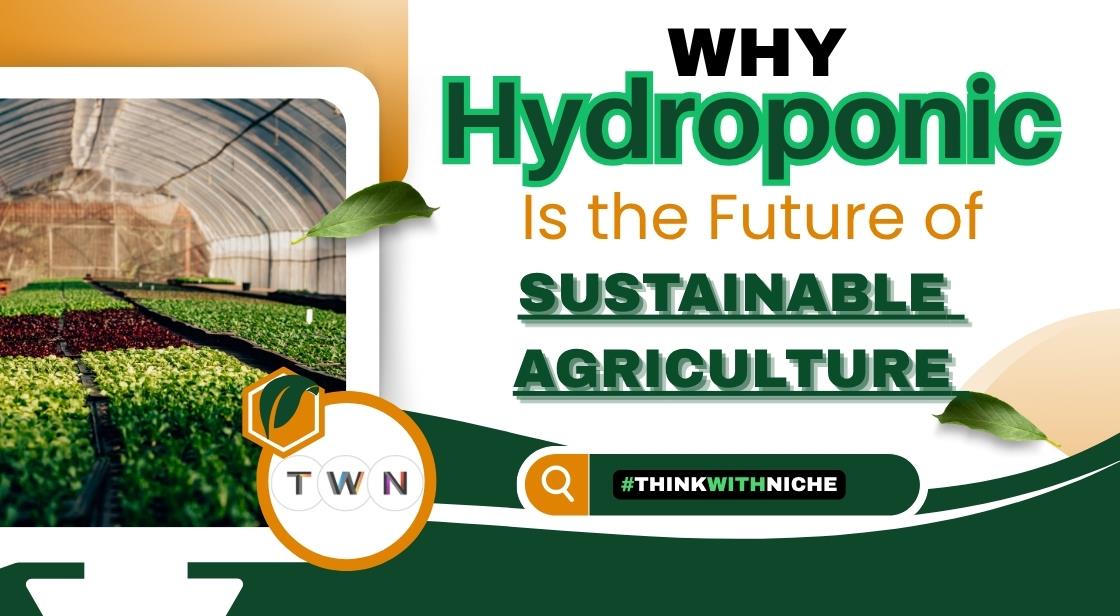Why Hydroponics Is the Future of Sustainable Agriculture?

Podcast
Post Highlight
At my home, a vibrant collection of philodendrons, particularly three distinct species, thrive in a peculiar yet effective environment. Their vitality isn't drawn from traditional soil, but from recycled water that sustains a lively community of African cichlids.
This ingenious setup, a blend of aquascaping and terrarium techniques, mirrors the ancient Chinese practice of rice-fish farming, yet embodies a distinctly modern approach – a testament to the principles of aquaponics, a close cousin of hydroponics.
The very essence of this home experiment encapsulates the promise of hydroponics: cultivation without soil, leveraging nutrient-rich water. This innovative method is no longer a niche curiosity but a burgeoning global industry, particularly gaining immense traction in India.
With rapid urbanization shrinking agricultural land, escalating concerns over water scarcity, and a growing consumer demand for organic, pesticide-free produce, hydroponics is emerging as a critical solution.
Bolstered by supportive government initiatives promoting agri-tech innovations, the Indian hydroponics market, valued at $1.4 billion in 2022, is projected to reach an astounding $5.3 billion by 2031, at a robust Compound Annual Growth Rate (CAGR) of 17.6%.
This article delves into the intricacies of hydroponics, its synergistic technologies, the landscape for investors, and the challenges that must be navigated to unlock its full potential.
Popular Post
Continue Reading..
What is Hydroponics? The Science of Soil-less Growth
At its core, hydroponics is a method of growing plants using mineral nutrient solutions dissolved in water, rather than soil. This soil-less technique allows for unparalleled control over the plant's nutritional intake, leading to optimized growth rates and significantly higher yields compared to conventional soil-based cultivation.
By eliminating soil, hydroponics mitigates various traditional farming challenges, including soil-borne pests and diseases, and the need for vast tracts of arable land. The controlled environment facilitates year-round production, irrespective of external climatic conditions.
The Global and Indian Hydroponics Market: A Growth Story
The global hydroponics market has experienced exponential growth, reflecting its growing recognition as a viable and sustainable agricultural practice. Valued at an estimated $14.57 billion in 2024, the global market is projected to reach approximately $34.32 billion by 2032, exhibiting a commendable CAGR of 11.3% from 2025. Another projection estimates the global market to reach $18.12 billion by 2034, growing at a CAGR of 12.60% from 2025.
In India, hydroponics is rapidly gaining traction, particularly in urban and peri-urban areas where land and water resources are increasingly constrained. The Indian hydroponics market, which was estimated at USD 218.75 million in 2023, is forecast to grow to USD 2,227.04 million by 2035, at an impressive CAGR of 21.43% from 2025 to 2035.
While initial reports from 2022 indicated a market size of $1.4 billion, more recent analyses suggest varying figures, with one report valuing it at USD 506.7 million in 2024, projected to reach USD 2,292.7 million by 2033 at a CAGR of 16.91%. Regardless of the slight variations in immediate figures, the overarching trend points to significant, sustained growth.
The market in India is broadly segmented into three primary areas:
-
Commercial Hydroponics: Holding the largest share at approximately 60% of the market, this segment is growing at an estimated 22% annually, driven by large-scale farms supplying produce to retail and food service industries.
-
Residential/Urban Farming: Accounting for about 25% of the market, this segment is expanding at an 18% annual growth rate, fueled by individual and community interest in growing their own fresh produce.
-
Research and Educational Purposes: Representing roughly 15% of the market, this segment is growing at 15% annually, as institutions explore new techniques and train future agri-tech professionals.
Also Read: How AI Technology is Transforming Agriculture to Combat Hunger
Driving Forces Behind the Hydroponics Boom
The rapid adoption and growth of hydroponics are propelled by several critical factors:
-
Rapid Urbanization and Shrinking Agricultural Land: As cities expand, arable land diminishes, making traditional agriculture less feasible. Hydroponics allows for cultivation in compact spaces, including rooftops, warehouses, and even indoors, within urban centers.
-
Water Scarcity and the Need for Water-Efficient Farming: Traditional farming is a massive consumer of water, accounting for about 80% of India's water usage. Hydroponics can reduce water consumption by up to 90% through recirculating systems, making it a highly water-efficient alternative in water-stressed regions.
-
Increasing Demand for Organic and Pesticide-Free Produce: Growing consumer awareness about health and food safety drives demand for produce free from harmful chemicals. Hydroponics, by its nature, offers a controlled environment that minimizes the need for pesticides and herbicides.
-
Climate Change and Unpredictable Weather Patterns: Hydroponic systems, often conducted in controlled environments, are insulated from extreme weather events, ensuring consistent year-round production regardless of droughts, floods, or temperature fluctuations.
-
Supportive Government Initiatives: Governments worldwide, including India, are recognizing the potential of agri-tech innovations like hydroponics and are providing incentives and support for their adoption.
Investment Landscape and Key Players in India
Investor interest in the hydroponics sector is on the rise, with growing capital inflows into innovative startups. In India, several noteworthy investments have recently been made in this emerging market.
-
UrbanKissan: A Bengaluru-based company specializing in large-scale vertical hydroponics, successfully raised $3 million from Kalari Capital in 2022.
-
Clover: Based in Hyderabad, Clover focuses on IoT-enabled large-scale hydroponic solutions, securing $5.5 million from Accel and Omnivore in 2021.
-
Future Farms: Operating commercial hydroponics farms in Chennai, Future Farms attracted $2 million from High Net Worth Individuals (HNIs) and family offices in 2023.
These investments highlight the confidence of venture capitalists and private investors in the scalability and profitability of hydroponic ventures. Other active players in the Indian market include Nutrifresh, Letcetra Agritech, Rise Hydroponics, Acqua Farms, and BitMantis Innovations.
Technology: The Brains Behind the Green Revolution
The true potential of hydroponics is unlocked through its seamless integration with cutting-edge technologies, ushering in the era of Agriculture 4.0.
-
IoT (Internet of Things) and Smart Sensors:
-
How it Integrates: IoT devices and smart sensors monitor and control crucial environmental parameters in real-time, including water levels, pH, temperature, light intensity, and nutrient concentration.
-
Benefits: This enables automated nutrient delivery, optimized resource usage, predictive maintenance, and early detection of plant health issues. Examples include smart hydroponics kits like Aerospring Hydroponics or CropX.
-
-
Artificial Intelligence (AI) and Machine Learning (ML):
-
How it Integrates: AI algorithms analyze vast datasets collected from sensors, weather forecasts, and plant growth patterns. They can optimize nutrient cycles, predict yield, detect diseases, and even recommend optimal growing conditions.
-
Benefits: Automated decision-making, highly accurate yield forecasting, and precise, dynamic control over resource usage lead to maximum efficiency. GroLab, for instance, uses AI-based systems to automate and optimize hydroponic operations.
-
-
Blockchain:
-
How it Integrates: Blockchain technology can create an immutable, transparent record of the entire crop lifecycle, from seed to harvest, and distribution.
-
Benefits: This ensures unparalleled transparency in the supply chain, guarantees quality standards, and helps eliminate middlemen, fostering trust among consumers. Startups like AgriLedger are providing blockchain-based solutions for farm-to-fork transparency.
-
-
Aeroponics:
-
How it Integrates: Often considered a subset or advanced form of hydroponics, aeroponics involves suspending plant roots in the air and misting them with nutrient solutions.
-
Benefits: This method allows for higher oxygen exposure to roots, leading to faster growth rates and even further reduced water usage compared to traditional hydroponics. NASA’s Viking Experiment famously pioneered aeroponics for growing crops in space, showcasing its efficiency.
-
-
Aquaponics:
-
How it Integrates: Aquaponics is a symbiotic system that combines aquaculture (fish farming) with hydroponics. Fish waste provides natural nutrients for the plants, which in turn filter and clean the water for the fish, creating a closed-loop ecosystem.
-
Benefits: It creates a self-sustaining system, eliminates the need for chemical fertilizers for plants, and boasts extremely high water efficiency. WaterFarmers Aquaponics in India is a prime example of this sustainable farming technique.
-
-
Vertical Farming Systems:
-
How it Integrates: Hydroponics is often the core technology used in vertical farms, which involve growing crops in vertically stacked layers, often indoors and under controlled conditions.
-
Benefits: This maximizes space efficiency, drastically reduces water consumption, and enables year-round production in urban areas. Companies like AeroFarms and UrbanKissan are actively deploying this model in India.
-
-
Solar-Powered Hydroponics:
-
How it Integrates: Solar panels power the entire hydroponic system, including water pumps, lighting, and environmental controls.
-
Benefits: This leads to significantly reduced operational costs, enhanced sustainability, and the ability to establish off-grid farming operations, particularly beneficial in remote areas. Projects like Solar Hydroponic farms in Rajasthan demonstrate its viability for desert agriculture.
-
-
Automation and Robotics:
-
How it Integrates: Robotics automate various labor-intensive tasks within the hydroponic system, such as planting, monitoring, pruning, and harvesting.
-
Benefits: This drastically reduces labor costs, increases precision, minimizes human error, and ensures consistent quality and yield. Companies like Iron Ox in the US utilize autonomous robots for hydroponic farming.
-
-
LED-Based Smart Lighting Systems:
-
How it Integrates: Advanced LED lights with customizable wavelengths deliver precise light spectrums tailored to specific plant needs, allowing for optimal growth without reliance on natural sunlight.
-
Benefits: This leads to faster plant growth cycles, superior energy efficiency, and a reduced carbon footprint, enabling cultivation in any indoor environment. Philips GreenPower LED systems are widely used in commercial hydroponics.
-
-
Data Analytics Platforms:
-
How it Integrates: These platforms aggregate and analyze data from IoT sensors, weather forecasts, genetic information, and plant growth patterns to provide actionable insights.
-
Benefits: They enable predictive farming, optimize resource management, and facilitate informed decisions for maximizing crop yield and quality. Agrivi, for example, offers cloud-based farm management solutions that integrate with hydroponic systems.
-
Challenges and Risks in the Hydroponics Journey
Despite its immense potential, the hydroponics market faces several significant hurdles:
-
High Initial Setup Costs: The investment required for setting up a sophisticated hydroponic farm, including specialized equipment, climate control systems, and technological integration, can be substantial, posing a barrier to entry for many.
-
Limited Awareness Among Traditional Farmers: Many traditional farmers lack knowledge and exposure to hydroponic techniques, and overcoming ingrained farming practices requires extensive education and demonstration.
-
Uncertain Regulatory Frameworks: As a relatively new and evolving agricultural method, specific regulatory frameworks and standards for hydroponically grown produce are still developing in some regions, creating ambiguity.
-
Scalability Concerns for Small Farmers: While commercial operations scale efficiently, making hydroponics accessible and economically viable for small-scale and individual farmers still presents a challenge.
-
Reliance on Electricity: Hydroponic systems, especially those with advanced controls and lighting, require a consistent and reliable power supply, which can be an issue in areas with unreliable grids.
-
Technical Expertise: Operating and maintaining a hydroponic system requires a certain level of technical expertise in plant nutrition, water chemistry, and system management.
However, these challenges also present opportunities for innovation in reducing costs, developing simpler systems, and providing comprehensive training and support to farmers and aspiring agripreneurs.
Government's Pivotal Role in Fostering the Hydroponics Ecosystem
The Indian government is playing an increasingly crucial role in fostering the hydroponics ecosystem through supportive policies and financial initiatives. In October 2024, the Union Government reportedly decided to include hydroponics, aquaponics, vertical farming, and precision agriculture under the Mission for Integrated Development of Horticulture (MIDH), a centrally sponsored scheme.
This move signifies a direct intent to promote these advanced farming practices. The Ministry of Agriculture and Farmers' Welfare has initiated the process of revising MIDH operational guidelines and cost norms, with an anticipated upward revision of 20% in cost norms.
Key government initiatives include:
-
PM-KUSUM Scheme: This scheme promotes solar-powered hydroponic farms, reducing operational costs and fostering sustainable, off-grid farming solutions.
-
Agri-Infra Fund: A significant ₹1 lakh crore fund has been allocated to support agri-tech infrastructure, providing capital for establishing and upgrading hydroponic facilities.
-
StartUp India: This flagship initiative offers crucial financial and incubation support for agri-tech startups, fostering innovation and entrepreneurship in the hydroponics sector.
-
Research & Development: Institutes like ICAR-Indian Institute of Horticultural Research (IIHR), ICAR-Central Potato Research Institute (CPRI), and ICAR-Central Institute for Subtropical Horticulture (CISH) are actively developing and standardizing hydroponic and aeroponic technologies, providing training and demonstrations to farmers.
These concerted efforts aim to create an enabling environment for hydroponics to flourish, aligning with the national goals of food security and agricultural modernization.
Investment Opportunities: Nurturing the Future of Food
Despite the challenges, hydroponics presents a diverse range of attractive investment opportunities:
-
Urban Hydroponic Farms: These farms cater to the escalating demand for locally produced, fresh, and pesticide-free vegetables in urban centers, minimizing transportation costs and ensuring immediate availability.
-
Community Hydroponics Projects: Promoting cooperative farming models in urban and peri-urban areas, these projects can empower local communities to produce their food, fostering self-sufficiency and reducing food miles.
-
Export-Oriented Hydroponics: Focusing on high-value crops like exotic herbs, medicinal plants, and specialty vegetables, these ventures can tap into lucrative international markets.
-
Technology & Infrastructure Providers: Investing in companies that develop and supply hydroponic equipment, smart sensors, AI-driven software, and integrated automation systems offers significant potential.
-
Training and Consultancy: Opportunities exist in providing specialized training and consultancy services to new farmers and businesses entering the hydroponics sector, bridging the knowledge gap.
As Gaurav Sishodia, Vice President, Agri-Food sector at Invest India, aptly states, "Hydroponics is more than just an innovative farming technique; it is the foundation of sustainable agriculture in an era of urbanisation and resource constraints. By harnessing cutting-edge technology, strategic investments and strong government support, we have a remarkable opportunity to redefine organic food production, making it more efficient, resilient and accessible along with the produce being pesticide-free."
The Future of Food: Why Hydroponics is Indispensable
Hydroponics, particularly when combined with allied technologies, forms the backbone of Agriculture 4.0, making it a pivotal player in urban farming, climate-resilient agriculture, and ensuring global food security. As climate change accelerates and puts unprecedented pressure on traditional farming methods, hydroponics systems offer a controlled, resource-efficient alternative that can yield consistent, high-quality produce.
The Indian hydroponics market is projected to reach $325 million by 2030 from $75 million in 2023, growing at a CAGR of over 20%. Globally, hydroponics is expected to grow at a CAGR of 18-20% by 2030, becoming a cornerstone of sustainable agriculture worldwide.
Investors, entrepreneurs, and policymakers can leverage this momentum by supporting early-stage startups, forging partnerships with government-backed agri-tech programs, and exploring urban-centric hydroponic projects.








